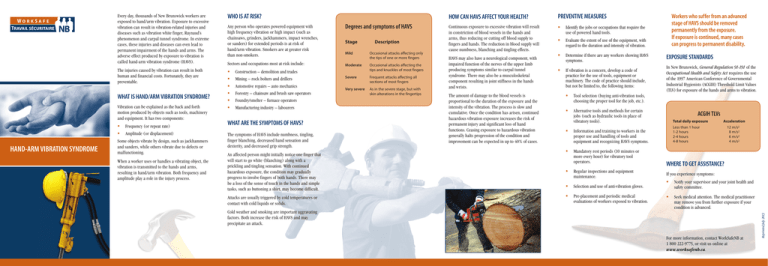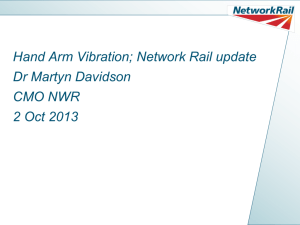Hand-arm Vibration Syndrome
advertisement

Who is at risk? The injuries caused by vibration can result in both human and financial costs. Fortunately, they are preventable. What is hand/arm vibration syndrome? Vibration can be explained as the back and forth motion produced by objects such as tools, machinery and equipment. It has two components: Frequency (or repeat rate) Amplitude (or displacement) HAND-ARM VIBRATION SYNDROME Some objects vibrate by design, such as jackhammers and sanders, while others vibrate due to defects or malfunctioning. When a worker uses or handles a vibrating object, the vibration is transmitted to the hands and arms, resulting in hand/arm vibration. Both frequency and amplitude play a role in the injury process. Any person who operates powered equipment with high frequency vibration or high impact (such as chainsaws, grinders, jackhammers, impact wrenches, or sanders) for extended periods is at risk of hand/arm vibration. Smokers are at greater risk than non-smokers. Degrees and symptoms of HAVS Mild Occasional attacks affecting only the tips of one or more fingers Sectors and occupations most at risk include: Moderate Occasional attacks affecting the tips and knuckles of most fingers Severe Frequent attacks affecting all sections of most fingers Very severe As in the severe stage, but with skin alterations in the fingertips Construction – demolition and trades Mining – rock bolters and drillers Automotive repairs – auto mechanics Forestry – chainsaw and brush saw operators Foundry/smelter – furnace operators Manufacturing industry – labourers What are the symptoms of havs? The symptoms of HAVS include numbness, tingling, finger blanching, decreased hand sensation and dexterity, and decreased grip strength. An affected person might initially notice one finger that will start to go white (blanching) along with a prickling and tingling sensation. With continued hazardous exposure, the condition may gradually progress to involve fingers of both hands. There may be a loss of the sense of touch in the hands and simple tasks, such as buttoning a shirt, may become difficult. Attacks are usually triggered by cold temperatures or contact with cold liquids or solids. Cold weather and smoking are important aggravating factors. Both increase the risk of HAVS and may precipitate an attack. Stage Description How can havs affect your health? Preventive measures Continuous exposure to excessive vibration will result in constriction of blood vessels in the hands and arms, thus reducing or cutting off blood supply to fingers and hands. The reduction in blood supply will cause numbness, blanching and tingling effects. Identify the jobs or occupations that require the use of powered hand tools. HAVS may also have a neurological component, with impaired function of the nerves of the upper limb producing symptoms similar to carpal tunnel syndrome. There may also be a musculoskeletal component resulting in joint stiffness in the hands and wrists. The amount of damage to the blood vessels is proportional to the duration of the exposure and the intensity of the vibration. The process is slow and cumulative. Once the condition has arisen, continued hazardous vibration exposure increases the risk of permanent injury and significant loss of hand functions. Ceasing exposure to hazardous vibration generally halts progression of the condition and improvement can be expected in up to 40% of cases. Evaluate the extent of use of the equipment, with regard to the duration and intensity of vibration. Workers who suffer from an advanced stage of HAVS should be removed permanently from the exposure. If exposure is continued, many cases can progress to permanent disability. Determine if there are any workers showing HAVS symptoms. Exposure standards If vibration is a concern, develop a code of practice for the use of tools, equipment or machinery. The code of practice should include, but not be limited to, the following items: In New Brunswick, General Regulation 91-191 of the Occupational Health and Safety Act requires the use of the 1997 American Conference of Governmental Industrial Hygienists (ACGIH) Threshold Limit Values (TLV) for exposure of the hands and arms to vibration. Tool selection (buying anti-vibration tools, choosing the proper tool for the job, etc.). Alternative tools and methods for certain jobs (such as hydraulic tools in place of vibratory tools). Information and training to workers in the proper use and handling of tools and equipment and recognizing HAVS symptoms. Mandatory rest periods (10 minutes or more every hour) for vibratory tool operators. ACGIH TLVs Total daily exposure Acceleration Less than 1 hour 1-2 hours 2-4 hours 4-8 hours 12 m/s2 8 m/s2 6 m/s2 4 m/s2 Where to get assistance? Regular inspections and equipment maintenance. If you experience symptoms: Selection and use of anti-vibration gloves. Notify your supervisor and your joint health and safety committee. Pre-placement and periodic medical evaluations of workers exposed to vibration. Seek medical attention. The medical practitioner may remove you from further exposure if your condition is advanced. For more information, contact WorkSafeNB at 1 800 222-9775, or visit us online at www.worksafenb.ca. Reprinted July 2013 Every day, thousands of New Brunswick workers are exposed to hand/arm vibration. Exposure to excessive vibration can result in vibration-related injuries and diseases such as vibration white finger, Raynaud’s phenomenon and carpal tunnel syndrome. In extreme cases, these injuries and diseases can even lead to permanent impairment of the hands and arms. The adverse effect produced by exposure to vibration is called hand-arm vibration syndrome (HAVS).





